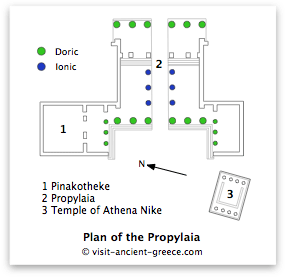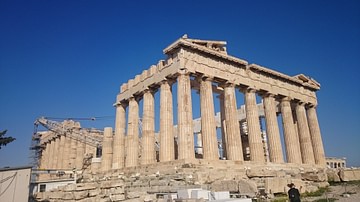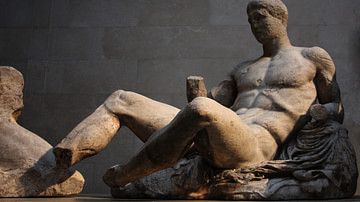
Propylaea is the name given to monumental gates or entranceways to a specific space, usually to a temple or religious complex and as such they acted as a symbolic partition between the secular and religious parts of a city. Less complex examples with a single entrance are known as a propylon. Propylaea were a feature of Minoan architecture in 17th century BCE Crete (e.g. at Ayia Triada) and Mycenaean architecture in the 14th century BCE (e.g. at Tiryns). In Classical Greece a monumental Propylon provided the entrance to the sanctuary at Olympia but the most famous and best preserved example of this type of structure is the magnificent Propylaea of the acropolis of Athens.
The Propylaea of Athens was built as part of Pericles great rebuilding programme for Athens in c. 437 BCE and was designed as a monumental entrance to the plateau of the acropolis and the great temple to Athena, the Parthenon. The project was begun as the Parthenon neared completion and was supervised by the architect Mnesicles (or Mnesikles) who managed to overcome the difficulties of incorporating the structure into the existing architecture of the Athena Nike bastion and the precinct of Artemis Brauronia and the differences in elevation of the chosen site. Work was suspended in 431 BCE following the opening stages of the Peloponnesian War but in fact was never resumed. However, the major parts of Mnesicles vision had fortunately been realised.
The principal entrance to the acropolis had always been on the west side of the escarpment since Mycenaean times and the Propylaea was built on the exact site of the Old Propylon (a modest columned porch) built from 490 BCE and destroyed by the Persians in 480 BCE. Constructed with white Pentellic marble, the new Propylaea lies on an east-west axis and was designed to mirror the architectural style and proportions of the nearby Parthenon. A steep bank 80 metres long and 10 metres wide (with steps added under Claudius c. 52 CE) leads up to the Propylaea which consists of a central porch in the style of a Doric temple with a six Doric column façade, a corridor with three Ionic columns either side and another six Doric columns on the west side exit. Independent wings stand on either side of the porch and it is the inner chambers of these annexes which were the part of the original project left unfinished. One of these wings, the Pinakotheke, measures 10.75 by 9 metres and was originally planned to be a gallery for art and a place for banqueting. The Propylaea actually provided five entrances, four for pedestrians and one larger central entrance for wheeled traffic and the coffered roof interior had a design in gold stars and palmettes on a blue background.
The span of the horizontal beams of the Propylaea roof is particularly impressive and much longer than the contemporary norm in Greek architecture. To assist the tensile strength and therefore the weight bearing capacity of the marble girders which supported the roof beams, curved short iron bars were inserted into troughs in the marble which when pressed flat by the weight of the covering beams reduced the possibility of the stone displacing when the roof was assembled. The only other known use of metal as a structural aid in Greek architecture is the Temple of Zeus at Agrigento (c. 490 BCE).
In front of the Propylaea is a massive pedestal of grey Hymettus marble, 10 metres (29 feet) high, on which once stood a quadriga sculpture (four-horse chariot) honouring the king of Pergamon, Eumenes II, following his victory in the Panthenaic Games of 178 BCE. In the first century CE the plinth was re-used to bear the statues of Anthony and Cleopatra and following their collapse in a hurricane in 31 CE the monument was re-dedicated in 35 CE to Marcus Vipsanius Agrippa who was seen as a great benefactor to the city.
Over the centuries the building saw service as a Byzantine bishop's palace, a Florentine palazzo and a Turkish governor's residence. In the mid-17th century CE a lightening strike or perhaps a canon shot ignited the gunpowder store within the Propylaea and the resulting explosion severely damaged the building. However, in the 20th and 21st century CE, restoration work has ensured that the Propylaea has regained something of its former glory and it still fulfils its original function for the modern visitor as a breathtaking entrance to the architectural wonders of the acropolis.





